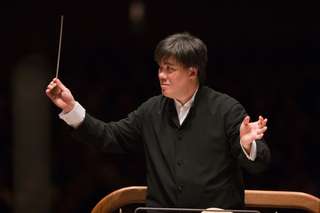|
Back
A Tale of Two Concerts New York
Avery Fisher Hall
09/18/2009 -
Gustav Mahler: Symphony No. 3
Petra Lang (mezzo)
Women of the Westminster Symphonic Choir, American Boychoir, New York Philharmonic, Alan Gilbert (conductor)

Alan Gilbert (© Chris Lee)
Many of us are pulling for Alan Gilbert. All reports indicate that he is a genuinely nice man, an intellectual conductor with a very clear podium manner. He has an interest in contemporary music and a particular penchant for the neglected repertoire of the 19th and early 20th centuries. He does not waste any time or energy with excessive conductorial antics or meaningless gestures. Bespectacled, he looks more like an accountant than a maestro. This of course should not matter in the slightest, but he is not a white man and thus is more acceptable in the polemical world of New York’s Upper West Side. And he has virtually no chance of making it big with the New York Philharmonic.
Frederick the Great used to say that King Chance was the most powerful ruler of man, and the Phil rolled snake eyes in their current search for a new leader. The plan was for the young Gilbert, who literally grew up with this orchestra (both of his parents were members and his mother is still in the first violin section), to be the figurehead while the flamboyant Riccardo Muti – the anti-Gilbert, if you will – would become the de facto if not the de jure music director. Not a bad plan at all, except Maestro Muti chose the Chicago Symphony instead, leaving Alan Gilbert to twist slowly in the wind. A pity, since Mr. Gilbert appears to show great promise. Once he is let go sometime during his first three year stint, replaced by a splashier (and most likely inferior) presence, he should do very well in another place in another town.
Choosing in his first week to tackle something gigantic, Mr. Gilbert presented the longest of all the Mahler symphonies, one that even the composer himself rejected for presentation with the Philharmonic when he had the reigns. This concert was a success even before the first note was struck, as Gilbert has rearranged the platform positioning of the orchestra, liberating the second violins to their rightful place in the front stage left and placing the violas in a much better central position where their sound boards do not face the back of the proscenium. This putting right bore instant fruit, especially in the eloquent second violin passages of the final movement. Even the cellos, now on the stage right side of center, were more crystalline, although this phenomenon might be my own prejudice, being a “left of the hall” kinda guy.
Additionally, the overall sound of this sometimes inconsistent ensemble was improved throughout, technically sound and remarkably precise, especially considering the 100 minute length of the piece. Having been in the house for both the opening week performances of both Masur and Maazel, I can assure you that this Gilbert product was by far the superior.
However, the performance itself left a lot to be desired. This was some of the most tedious Mahler playing that I have heard in many a year. The thirty-five minute first movement was little more than a slough, complete with very heavily laden phrasing that produced more of a soporific than a majestic effect. Oddly, Mr. Gilbert made his soloist, Petra Lang, sit up front through the entire proceedings, her face limited to expressionlessness and at least some degree of discomfort. Making the women and especially the children of the chorus sit through it all amounted to cruel and unusual punishment.
The second movement only served to emphasize the torpor, while the vitally important third movement, although played accurately by such as the posthorn soloist – Murphy’s Law made him only crack his very last note – had no childlike quality, no effervescence. This same lack of frisson made the poor children’s part (in the fifth movement) a surprisingly emotionless expression of “Heavenly Joy”. Each individual phrase was left hanging to display its corpulence; there was only an unbearable heaviness of being.
Finally, Maestro committed a rookie mistake, commencing the final Adagio much too loudly, quickly painting himself into an acoustical corner where there was nowhere to go when the painstaking crescendo needed to blossom. Mahler had suggested a brief intermission after the lengthy first movement, although hardly anyone takes his notion seriously. But guess what? The savvy conductor of both the Vienna and New York orchestras knew that without a retuning, even the finest musicians will suffer from poor intonation after so much fortissimo playing for so long. Sure enough, by the work’s conclusion, that surprisingly pleasing New York Philharmonic sound had vanished. Maybe in November, when Maestro Muti comes for one last hurrah, it will hang around until the conclusion of the concert.
Fred Kirshnit
|